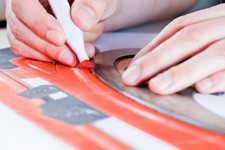Introduction:
Design and Manufacture at National 5, introduces students to the world of product design and manufacturing. Creativity is at the heart of this Course and its combination with technology makes it exciting and dynamic. The Course combines science, mathematics and technology with design and manufacturing. In the Course, students are encouraged to exercise imagination, creativity and logical thinking.
The Course provides students with skills that allow them to learn live and work more effectively in our advancing technological society. It allows them to become not just effective contributors but informed and discerning consumers.
Course Aims:
The aims of the Course are to enable students to develop:
- Skills in the design and manufacturing prototypes and products.
- Knowledge and understanding of manufacturing processes and materials.
- An understanding of the impact of design and manufacturing technologies on our environment and society.
Course Structure and Assessment:
To gain the award of the Course, the learner must pass all of the Units as well as the Course assessment. Course assessment will be graded A –D, unlike unit work, which will be graded on a pass/fail basis.
1. Units are structured as follows:
Unit One: Design
This Unit covers the product design process from brief to resolved design proposals, including specification. It helps students to develop skills in initiating, developing and communicating design proposals. It allows them to develop an appreciation of the design process and the importance of evaluating and resolving design proposals. It allows them to develop an appreciation of design concepts and the various factors that influence the design of products. Unit one is broken down further into 3 specific outcomes:
1. Identify factors that influence design and apply these in a design task.
2. Develop and communicate design concepts for a design task.
3. Evaluate existing products from today’s markets.
Unit Two: Materials and Manufacturing
This Unit covers the product design process from design proposals to prototype or product. It helps students to realise their design by manufacturing their ideas. It allows learners to develop practical skills that are invaluable in the design process. It helps them gain an appreciation of the properties and uses of materials as well as a range of manufacturing processes and techniques. Unit Two is broken down further into 4 specific outcomes:
1. Investigate materials for manufacturing tasks in a workshop context
2. Prepare for manufacturing tasks in a workshop context
3. Plan and implement a manufacturing sequence for a prototype
4. Review the manufacturing processes and finished prototype
2. Course Assessment:
SQA will produce and conduct Course assessments meaning that the following assessments will be moderated externally by the SQA.
Component One: Course Assignment (100 Marks = 55% of the total mark)
The assignment requires students to demonstrate aspects of challenge and application in a practical context. Learners will apply knowledge and skills from the Units to produce a solution to an appropriately challenging design problem. The Course Assignment will assess two areas:
- Design skills (30% of Assignment marks). Candidates will produce a folio covering the following areas:
- ideas
- development
- communication
- evaluation
- Practical skills (25% of Assignment marks). Candidates will produce a prototype. The prototype will allow learners to demonstrate practical skills in:
- measuring and marking out
- cutting, shaping and forming
- assembly of components
- finishing
Component Two: Written Exam (80 marks = 45% of the total mark).
The question paper requires learners to demonstrate aspects of breadth and application in theoretical contexts. Learners will apply breadth of knowledge from across the Units and depth of understanding, to produce descriptions and explanations related to theoretical design and manufacture contexts.
Course Progression:
Higher Design and Manufacture.
Advanced Higher Design and Manufacture.
Possible further study and career routes for students:
Product Design (e.g. electronics, auto-motives, communications), Interior design,
Manufacturing apprenticeships, Design Engineering, Architecture, and Quantity Surveying.
